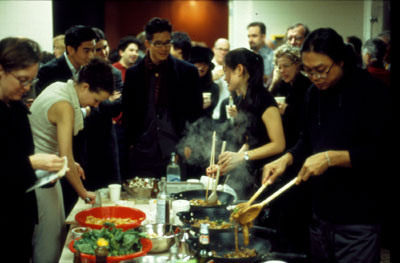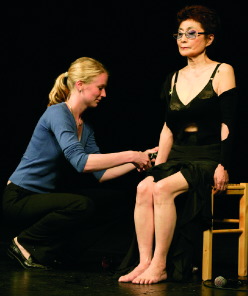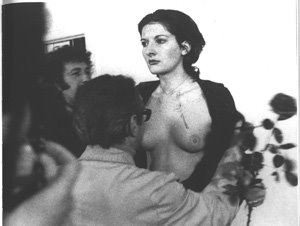My idea is that, beyond the fact that it's so ill-defined it can be practically anything, and so "whatever you do, it works", several more specific characteristics make it a great means of expression for groups with a strong sense of identity (as is the case with minorities).
- First, its rebellious nature. This is probably the most commonly known quality of performance, which, in my eyes, has done it just as much harm as it has publicized it. True, it puts performance art on the side of the underdogs, giving the "rebels" a chance to speak up. But how "up" is it? Who listens to them? Other performance artists and a tiny crowd of admirers. At least, that was the case with performance art (as it was defined by those who did it and saw it) for the past decades. A scandal is good every once in a while, but constant scandals are simply not a scandal any more. They tend to be tedious, long events where the suffering and pain of the performers brings suprizingly more embarrassment than empathy. Nonetheless, scandal, if used in a fresh way, can be good. It also emphasizes the difference, the otherness, the identity of the other, thus allowing this other to appear as an actual player.

Rudolf Schwarzkogler, Aktion (1965)
- Performance art looks for communication, but not through a mimetic de-monstration. Instead, it puts an accent on the very being, looking for the communicative aspects of reality. This can mean simply performing something, as in executing an action (see Althamer's Film), or it can mean looking at being in an objectifying way, like Vanessa Beecroft or Santiago Sierra might be doing.

What may come as a surprize is that this objectification can actually get us closer to the identity of the people. We feel empathy for Sierra's performers; we somehow refuse to see pure objects in Beecroft's girls. We feel obliged (yes, a moral category!) to project on them a presumed humanity, to see them as people, to ask ourselves about them, about their position, role, about why they are doing what they are doing and why we are doing what we are. This brings another point,
- The creation of intimacy. Look at Rirkrit Tiravanija with his exhibitions- turned- food- feasts, look at the classical Yoko Ono's Cut Piece, or even at the more drastic Rhythm O by Marina Abramovic.



They all share a space of intimacy, of sharing, of actually living together. This is a game of acknowledgement, of personal limits being overcome. It is creating a space where it is difficult for me to say something is simply a "good" or "bad" show, because I get involved (remember the Bill T. Jones case?). I don't need to actually be a "participant", i.e. I don't need to be performing an action, but I need to feel that the bond between me and what is happening on the "stage" (or in the "framework", to use an excellent term by the great Irving Goffman), that this bond goes beyond a show.
Technorati:

3 comments:
I would add the characteristic of embodied relationship, or of the pregnance of every relationship been [politically] embodied.
it is awfuly stupid
...and pretentious
Post a Comment